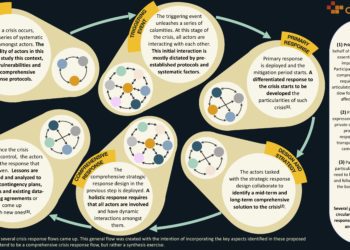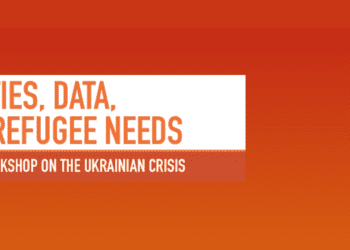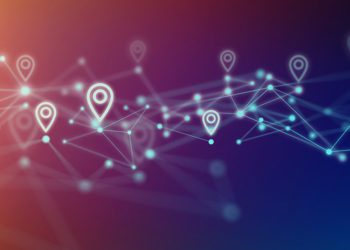Introduction
Preparedness for emergency contingencies requires access to reliable and timely data, as well as the availability of analytical methods that can be used by policy makers to translate the data into effective responses. In addition to the numerous analytical methods available, the multiplicity of public and private data repositories and the differing interests of data providers makes it difficult to coordinate appropriate responses during emergency events.
In response to the rapid evolution of disruptive information technologies, and the accelerated frequency of events that threaten human populations (wars, climate change, economic crisis), CrisisReady, in association with the Universidad del Rosario and the Universidad Nacional de Colombia, organized a workshop in Bogotá, Colombia to discuss, hand-in-hand with policy makers, the importance of the availability and timely use of high-quality data in response to humanitarian crises, with an emphasis on health emergencies.
The participants of this workshop included multilateral organizations (OIM, PNUD, OPS, Red Cross, iMMAP), national NGOs (Karisma), academic research groups, government agencies (National Institute of Health, National Department of Statistics), and private corporations (Procalculo). The main goal of the workshop was to discuss the need to build a network composed of multiple actors that facilitates the response to humanitarian crises.
Goals of the workshop:
- Build a network of key actors surrounding humanitarian crisis response.
- Identify the role data analysis can play at the different junctures throughout the development of a crisis.
- Identify the information, analyses, and data access needed that will facilitate resilience in times of humanitarian crises.
The Use and Nature of Data
Discussions that took place during the workshop focused on three overarching themes: data availability; data sources; and data resolution. These themes could be used to determine appropriate modes of analysis to address policy concerns.
- Data availability (e.g. public, private)
Data availability dictates who can use the data (i.e. certain data programs like Data for Good will not allow governments to access their data) and will therefore inform both the need for partnerships and the need for privacy protection strategies. - Data sources (e.g. mobility, satellite mapping, remote sensing)
The source of the data informs the what type of biases the data might carry with, what kind of coverage it has, what kind of technological solutions will be needed to store and manipulate the data and what kind of privacy concerns might be necessary to take into account before proceeding. - Data resolution (e.g. spatial, temporal, spectral, radiometric)
Data resolution dictates the granularity of the analyses that are possible as well as the need for aggregation techniques which themselves can introduce bias. Aggregation is a common technique used to protect data privacy, however, it is often not enough to ensure it. Low resolution data doesn’t necessarily imply anonymous data.
Migration and Human Displacement
The participants of the workshop were particularly interested in exploring innovative methods in accessing data that could inform predictive mobility models. This was due in part to the concerns over migration and internal displacement, and their impact on emergency response operations in Colombia.
The discussion highlighted two major concerns, the first being that private institutions, namely telecommunication companies, are reticent to share data with other actors, making it hard to incorporate novel datasources into analysis flows; and the second being that migration patterns often include vulnerable populations, which heighten concerns about individual privacy and identification. Despite these concerns, participants agreed that using novel data to visualize large-scale patterns of displacement could optimize the allocation of resources and deployment of aid during emergency events.
Use of Data During Emergency Events
Additional questions discussed during the workshop included:
- How do we collect and share data between different actors during an emergency?
- How do we complement routine data collection with data collected during emergency?
- How can we use these datasets to allow for a more efficient and equitable distribution of resources at the time of an emergency?
The timeframes of enacting policy are often misaligned with the timeframes given to research efforts. Collaboration between policy makers and researchers is further complicated by the need to establish data-sharing agreements and collaboration protocols. Participants voiced the difficulty of maintaining funding in between crises, which frequently causes the collaborations initiated in the midst of response efforts to run out of steam and dissolve prematurely. As a consequence, the skills, resources, and networks that were developed during this period are often lost.
Participants stated that analytic pipelines can be useful tools for decision makers and can allow for knowledge translation when tools are created in collaboration between policy makers and researchers. In this context, analytics pipelines can be designed to encourage the iterative development of short data flows that can serve as a point of communication between policymakers and researchers. As common understanding between policy makers and researchers is achieved, the pipeline can be further developed to support more sophisticated data flows. These new streams of data can be used to adjust research methodologies to policy-specific issues.
Privacy and Data Providers
Governments may feel the need to loosen data privacy regulations when they are put under pressure during emergency events. Organizations of the civil society may deter urgent response efforts in their goal of protecting individual rights. The introduction of differential privacy and federated learning methods were proposed to be included in methods of data analysis to safeguard individual privacy.
Differential Privacy (DP) is widely considered the “gold standard” of privacy protection for statistical releases. The system introduces random noise into released statistics to ensure that each individual is hidden while population-level signals are preserved. Conventional methods of removing personally identifiable information (PII) or aggregating data above the individual level tend to be antiquated, inadequate, and vulnerable to attacks.
Design Thinking Workshop
A mapping exercise allowed the participants to identify relevant stakeholders and processes in the emergency management cycle, and to summarize this into a data journey infographic.
Participants identified six stages (listed below) of a response to an emergency. For each stage, discussions about the role of data analytics were held.
- Prior context and vulnerabilities
- Triggering event
- Primary care
- Design and strategy
- Integral response
- Evaluation and design
Conclusions and Recommendations
- Standards for data sharing and social connections that exist prior to a crisis can have a significant impact on response operations and the resilience of affected populations and organizations.
This includes, among others, inequalities that increase vulnerabilities of specific populations, as well as logistical difficulties that hamper cooperation efforts. If there are no prior data and knowledge-sharing agreements, as well as social networks among response teams that facilitate collaborations between institutions, the response to the crisis will be fragmented. - There is a need to create incentives for private companies to provide access to data during disasters and emergencies.
Ideally, these incentives should be created by the government and should be taken as an opportunity to further promote collaboration (e.g. by creating grant programs that encourages private companies to collaborate with academia to develop methodologies that would use corporate data to optimize crisis response without having to relinquish control of the data to the government). - Data privacy tends to be ignored in the context of emergencies. Data privacy standards in Colombia are not well established, and it often falls on the shoulders of the civil society to monitor privacy violations.
- There is a pressing need to go beyond data analytics and dashboards. This includes adding a human component to complement analytics, and a stronger focus on sustained practices for knowledge translation for public policy.
When faced with the need to engage with data analysis, crisis response organizations, as public entities, are often required to open bids for hiring external services. These projects are often geared towards technological requirements and “products” and the support of a policy expert (which we deem essential) is often neglected.



